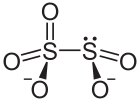| Revision as of 17:34, 21 January 2011 editWickey-nl (talk | contribs)Extended confirmed users7,037 edits Chemistry← Previous edit | Revision as of 17:20, 26 January 2011 edit undoWickey-nl (talk | contribs)Extended confirmed users7,037 edits ChemboxNext edit → | ||
| Line 10: | Line 10: | ||
| | ImageSize1 = | | ImageSize1 = | ||
| | ImageName1 = | | ImageName1 = | ||
| | IUPACName = | | IUPACName = disulfite <ref>{{RedBookRef|page=130}}</ref> | ||
| | OtherNames = metabisulfite ion<br />pyrosulfite | | OtherNames = metabisulfite ion<br />pyrosulfite | ||
| | Section1 = {{Chembox Identifiers | | Section1 = {{Chembox Identifiers | ||
| Line 19: | Line 19: | ||
| }} | }} | ||
| | Section2 = {{Chembox Properties | | Section2 = {{Chembox Properties | ||
| | Formula = S<sub>2</sub>O<sub>5 |
| Formula = S<sub>2</sub>O<sub>5 | ||
| | MolarMass = | | MolarMass = | ||
| | Appearance = | | Appearance = | ||
| Line 29: | Line 29: | ||
| }} | }} | ||
| A '''disulfite''', commonly known as '''metabisulfite''', is a ] containing the '''disulfite ion''' ('''metabisulfite ion''') S<sub>2</sub>O<sub>5</sub><sup>2−</sup>. | A '''disulfite''', commonly known as '''metabisulfite''', is a ] containing the '''disulfite ion''' ('''metabisulfite ion''') . | ||
| ==Chemistry== | ==Chemistry== | ||
Revision as of 17:20, 26 January 2011
Not to be confused with Bisulfite. | |
| Names | |
|---|---|
| IUPAC name disulfite | |
| Other names
metabisulfite ion pyrosulfite | |
| Identifiers | |
| PubChem CID | |
| CompTox Dashboard (EPA) | |
| Properties | |
| Chemical formula | S2O5 |
| Except where otherwise noted, data are given for materials in their standard state (at 25 °C , 100 kPa).
| |
A disulfite, commonly known as metabisulfite, is a chemical compound containing the disulfite ion (metabisulfite ion) .
Chemistry
Production of the disulfite ion
The disulfite ion is a dimer of the bisulfite ion (HSO3). It can arise from:
In aqueous solution, the disulfite ion is formed in minor amounts by dehydration of bisulfite in an equilibrium:
Although the equilibrium lies far to the left, evaporation of a bisulfite salt will produce a substantial amount of disulfite.
In fact, disulfite is the ion of disulfurous acid (pyrosulfurous acid), which originates from sulfurous acid in accordance with the dehydration reaction above:
- 2 H2SO3 → 2 HSO3 + 2 H → H2S2O5 + H2O
addition
The disulfite ion also arises from the addition of sulfur dioxide to the sulfite ion:
| HSO3 SO3 + SO2 |
 |
Other reactions
In aqueous solution, disulfite salts decompose with acids:
S2O5 + H → HSO3 + SO2
Examples of disulfites
- sodium metabisulfite (E223) and potassium metabisulfite (E224) are used as a preservative and antioxidant in food.
References
- International Union of Pure and Applied Chemistry (2005). Nomenclature of Inorganic Chemistry (IUPAC Recommendations 2005). Cambridge (UK): RSC–IUPAC. ISBN 0-85404-438-8. p. 130. Electronic version.
- Bassam Z. Shakhashiri: Chemical demonstrations: a handbook for teachers of chemistry The University of Wisconsin Press @Google Books, 1992, p.9